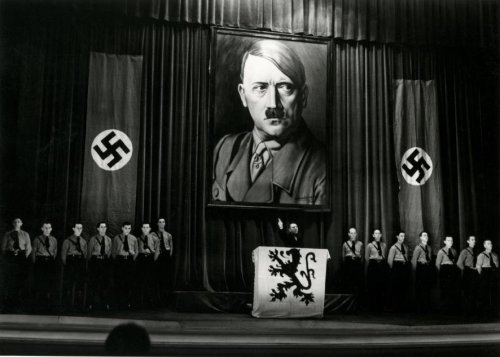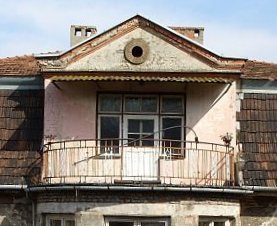|
Symcha Spira
Symcha Spira (? – 1944), also known as Symche Spira, served as the head of the Krakow ghetto Jewish police during the Holocaust. Biography According to survivors' testimony, before World War II Spira was an impoverished glazier and carpenter who practiced Orthodox Judaism. He was known to wear a full beard and kapoteh. In the early days of the Krakow ghetto, Spira served as a low level clerk for the Judenrat. In the summer of 1940 the '' Jüdischer Ordnungsdienst'' (OD) of Krakow was established, and Spira filed for a transfer. While serving there he quickly found favor in the eyes of the Germans, despite being near illiterate and having difficulty communicating in both German and Polish. After his transfer, he became a commander of the Kraków Ghetto Jewish Police, at the recommendation of the German forces. After taking this role his appearance would change, adopting the police uniform in place of religious wear and removing his beard entirely. One power that ... [...More Info...] [...Related Items...] OR: [Wikipedia] [Google] [Baidu] |
Płaszów Concentration Camp
Płaszów is a suburb of Kraków, Poland, now part of Podgórze district. Formerly a separate village, it became a part of the Greater Kraków in 1911 under the Austrian Partition of Poland as the 21st cadastral district of the city. During World War II, it was the location of Kraków-Płaszów concentration camp for Jews deported from the Kraków Ghetto, as well as other prisoners from across occupied Poland.Plaszow Concentration Camp hosted by Krakow-Poland.com retrieved from the , 16 November 2013. See also *[...More Info...] [...Related Items...] OR: [Wikipedia] [Google] [Baidu] |
Collaboration With Nazi Germany And Fascist Italy
In World War II, many governments, organizations and individuals collaborated with the Axis powers, "out of conviction, desperation, or under coercion." Nationalists sometimes welcomed German or Italian troops, believing they brought liberation from colonization. The Danish, and Belgian and Vichy French governments attempted to appease or bargain with the invaders, in hopes of mitigating harm to their citizens and economies. Some countries cooperated with Italy and Germany because they wanted to regain territory lost during and after the First World War or which their nationalist citizens simply coveted. Others, such as France, already had strong fascist movements and/or anti-semitic sentiment, which the invaders validated and empowered. Individuals such as Hendrik Seyffardt in the Netherlands and Theodoros Pangalos in Greece saw collaboration as a path to power in their country. Others believed that Germany would prevail, and either wanted to be on the winning side, or fea ... [...More Info...] [...Related Items...] OR: [Wikipedia] [Google] [Baidu] |
Schindler's List
''Schindler's List'' is a 1993 American epic historical drama film directed and produced by Steven Spielberg and written by Steven Zaillian. It is based on the 1982 novel ''Schindler's Ark'' by Australian novelist Thomas Keneally. The film follows Oskar Schindler, a German industrialist who saved more than a thousand mostly Polish-Jewish refugees from the Holocaust by employing them in his factories during World War II. It stars Liam Neeson as Schindler, Ralph Fiennes as SS officer Amon Göth, and Ben Kingsley as Schindler's Jewish accountant Itzhak Stern. Ideas for a film about the ''Schindlerjuden'' (Schindler Jews) were proposed as early as 1963. Poldek Pfefferberg, one of the ''Schindlerjuden'', made it his life's mission to tell Schindler's story. Spielberg became interested when executive Sidney Sheinberg sent him a book review of ''Schindler's Ark''. Universal Pictures bought the rights to the novel, but Spielberg, unsure if he was ready to make a film about the Holoca ... [...More Info...] [...Related Items...] OR: [Wikipedia] [Google] [Baidu] |
Schindler's Ark
''Schindler's Ark'' is a historical novel published in 1982 by the Australian novelist Thomas Keneally. The United States edition of the book was titled ''Schindler's List;'' it was later reissued in Commonwealth countries under that name as well. The novel won the Booker Prize and was awarded the ''Los Angeles Times'' Book Prize for Fiction in 1983. The book tells the story of Oskar Schindler, a member of the Nazi Party who becomes an unlikely hero by saving the lives of 1,200 Jews during the Holocaust. It follows actual people and events, with fictional dialogue and scenes added by the author where exact details are unknown. Keneally wrote a number of well-received novels before and after ''Schindler's Ark''; however, in the wake of its highly successful 1993 film adaptation directed by director Steven Spielberg, it has since gone on to become his most well-known and celebrated work. In 2022, the novel was included on the "Big Jubilee Read" list of 70 books by Commonwealth ... [...More Info...] [...Related Items...] OR: [Wikipedia] [Google] [Baidu] |
Thomas Keneally
Thomas Michael Keneally, AO (born 7 October 1935) is an Australian novelist, playwright, essayist, and actor. He is best known for his non-fiction novel ''Schindler's Ark'', the story of Oskar Schindler's rescue of Jews during the Holocaust, which won the Booker Prize in 1982. The book would later be adapted into Steven Spielberg's 1993 film ''Schindler's List'', which won the Academy Award for Best Picture. Early life Both Keneally's parents (Edmund Thomas Keneally and Elsie Margaret Coyle) were born to Irish fathers in the timber and dairy town of Kempsey, New South Wales, and, though born in Sydney, his early years were also spent in Kempsey. His father, Edmund Thomas Keneally, flew for the Royal Australian Air Force in World War II, then returned to work in a small business in Sydney. By 1942, the family had moved to 7 Loftus Crescent, Homebush, a suburb in the inner west of Sydney and Keneally was enrolled at Christian Brothers St Patrick's College, Strathfield. Shortly ... [...More Info...] [...Related Items...] OR: [Wikipedia] [Google] [Baidu] |
Amon Göth
Amon Leopold Göth (; alternative spelling ''Goeth''; 11 December 1908 – 13 September 1946) was an Austrian SS functionary and war criminal. He served as the commandant of the Kraków-Płaszów concentration camp in Płaszów in German-occupied Poland for most of the camp's existence during World War II. Göth was tried after the war by the Supreme National Tribunal of Poland at Kraków and was found guilty of personally ordering the imprisonment, torture, and extermination of individuals and groups of people. He was also convicted of homicide, the first such conviction at a war crimes trial, for "personally killing, maiming and torturing a substantial, albeit unidentified number of people." Göth was executed by hanging not far from the former site of the Płaszów camp. The 1993 film ''Schindler's List'', in which Göth is portrayed by Ralph Fiennes, depicts his running of the Płaszów concentration camp. Early life and career Amon Göth, an only child named afte ... [...More Info...] [...Related Items...] OR: [Wikipedia] [Google] [Baidu] |
Kraków-Płaszów Concentration Camp
, known for = , location = , coordinates = , built by = , operated by = Nazi Germany , commandant = Amon Göth (until September 1944)Arnold Büscher (September 1944 – January 1945) , original use = , construction = , in operation = 28 October 1942 – January 1945 , gas chambers = , prisoner type = , inmates = , killed = , liberated by = Red Army, 20 January 1945 , notable inmates = , notable books = , website = Płaszów () or Kraków-Płaszów was a Nazi concentration camp operated by the SS in Płaszów, a southern suburb of Kraków, in the General Governorate of German-occupied Poland. Most of the prisoners were Polish Jews who were targeted for destruction by Nazi Germany during the Holocaust. Many prisoners died because of executions, forced labor, and the poor conditions in the camp. The camp was evacuated in J ... [...More Info...] [...Related Items...] OR: [Wikipedia] [Google] [Baidu] |
Final Solution
The Final Solution (german: die Endlösung, ) or the Final Solution to the Jewish Question (german: Endlösung der Judenfrage, ) was a Nazi plan for the genocide of individuals they defined as Jews during World War II. The "Final Solution to the Jewish question" was the official code name for the murder of all Jews within reach, which was not restricted to the European continent. This policy of deliberate and systematic genocide starting across German-occupied Europe was formulated in procedural and geopolitical terms by Nazi leadership in January 1942 at the Wannsee Conference held near Berlin, and culminated in the Holocaust, which saw the murder of 90% of Polish Jews, and two-thirds of the Jewish population of Europe. The nature and timing of the decisions that led to the Final Solution is an intensely researched and debated aspect of the Holocaust. The program evolved during the first 25 months of war leading to the attempt at "murdering every last Jew in the German gra ... [...More Info...] [...Related Items...] OR: [Wikipedia] [Google] [Baidu] |
Polish People
Poles,, ; singular masculine: ''Polak'', singular feminine: ''Polka'' or Polish people, are a West Slavic nation and ethnic group, who share a common history, culture, the Polish language and are identified with the country of Poland in Central Europe. The preamble to the Constitution of the Republic of Poland defines the Polish nation as comprising all the citizens of Poland, regardless of heritage or ethnicity. The majority of Poles adhere to Roman Catholicism. The population of self-declared Poles in Poland is estimated at 37,394,000 out of an overall population of 38,512,000 (based on the 2011 census), of whom 36,522,000 declared Polish alone. A wide-ranging Polish diaspora (the '' Polonia'') exists throughout Europe, the Americas, and in Australasia. Today, the largest urban concentrations of Poles are within the Warsaw and Silesian metropolitan areas. Ethnic Poles are considered to be the descendants of the ancient West Slavic Lechites and other tribes that inhabite ... [...More Info...] [...Related Items...] OR: [Wikipedia] [Google] [Baidu] |
High Holy Days
The High Holidays also known as the High Holy Days, or Days of Awe in Judaism, more properly known as the Yamim Noraim ( he, יָמִים נוֹרָאִים, ''Yāmīm Nōrāʾīm''; "Days of Awe") #strictly, the holidays of Rosh HaShanah ("Jewish New Year") and Yom Kippur ("Day of Atonement"); #by extension, the period of ten days including those holidays, known also as the Ten Days of Repentance (''Aseret Yemei Teshuvah''); or, #by a further extension, the entire 40-day penitential period in the Jewish year from Rosh Chodesh Elul to Yom Kippur, traditionally taken to represent the forty days Moses spent on Mount Sinai before coming down with the second ("replacement") set of the Tablets of Stone. Etymology The term High Holy Days most probably derives from the popular English phrase, “high days and holydays”. The Hebrew equivalent, "''Yamim Noraim''" ( he, ימים נוראים), is neither Biblical nor Talmudic. Professor Ismar Elbogen, author of “Jewish Liturgy in it ... [...More Info...] [...Related Items...] OR: [Wikipedia] [Google] [Baidu] |
Daycare
Child care, otherwise known as day care, is the care and supervision of a child or multiple children at a time, whose ages range from two weeks of age to 18 years. Although most parents spend a significant amount of time caring for their child(ren), child care typically refers to the care provided by caregivers that are not the child's parents. Child care is a broad topic that covers a wide spectrum of professionals, institutions, contexts, activities, and social and cultural conventions. Early child care is an equally important and often overlooked component of child's developments. Care can be provided to children by a variety of individuals and groups. Care facilitated by similar-aged children covers a variety of developmental and psychological effects in both caregivers and charge. This is due to their mental development being in a particular case of not being able to progress as it should be at their age. This care giving role may also be taken on by the child's extended f ... [...More Info...] [...Related Items...] OR: [Wikipedia] [Google] [Baidu] |






